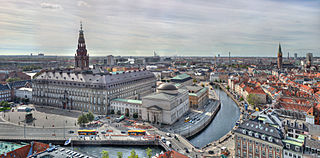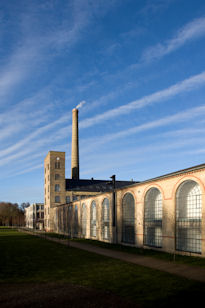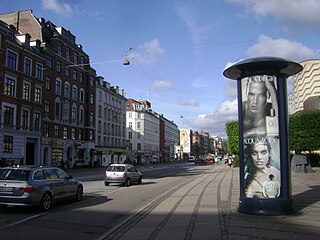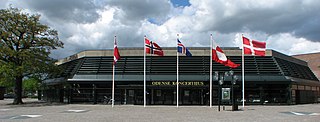
Copenhagen is the capital and most populous city of Denmark, with a population of around 1.4 million in the urban area, and more than 2 million in the wider Copenhagen metropolitan area. The city is on the islands of Zealand and Amager, separated from Malmö, Sweden, by the Øresund strait. The Øresund Bridge connects the two cities by rail and road.
Malmö is the largest city in the Swedish county (län) of Scania (Skåne). It is the third-largest city in Sweden, after Stockholm and Gothenburg, and the sixth-largest city in the Nordic region, with a municipal population of 357,377 in 2022. The Malmö Metropolitan Region is home to over 700,000 people, and the Øresund Region, which includes Malmö and Copenhagen, is home to 4 million people.

Nexø, sometimes spelled Neksø, is a town on the east coast of the Baltic island of Bornholm, Denmark. With a population of 3,668, it is the second largest town, as well as the largest fishing port on the island. Fishing was previously the mainstay of the town's economy. Nexø is also the site of a distillery and a mustard factory. The town is also a port of call for the passenger ferries linking Bornholm with Kołobrzeg in Poland. Dueodde, the largest beach on Bornholm, is located south of Nexø, in the southeastern corner of the island.
The Social Democrats is a social democratic political party in Denmark. A member of the Party of European Socialists (PES), the Social Democrats have 50 out of 179 members of the Danish parliament, Folketing, and three out of fourteen MEPs elected from Denmark.

Strøget is a pedestrian, car free shopping area in Copenhagen, Denmark. This popular tourist attraction in the centre of town is one of the longest pedestrian shopping streets in Europe at 1.1 km. Located at the centre of the old city of Copenhagen, it has long been one of the most high-profile streets in the city. The pedestrianisation of Strøget in 1962 marked the beginning of a major change in the approach of Copenhagen to urban life; following the success of the initiative the city moved to place a much greater emphasis on pedestrian and bicycle access to the city at the expense of cars. This approach has in turn become internationally influential.

Christianshavn is a neighbourhood in Copenhagen, Denmark. Part of the Indre By District, it is located on several artificial islands between the islands of Zealand and Amager and separated from the rest of the city centre by the Inner Harbour. It was founded in the early 17th century by Christian IV as part of his extension of the fortifications of Copenhagen. Originally, it was laid out as an independent privileged merchant's town with inspiration from Dutch cities but it was soon incorporated into Copenhagen proper. Dominated by canals, it is the part of Copenhagen with the most nautical atmosphere.

Kongens Enghave, commonly known as Sydhavnen or the postal district of 2450 Copenhagen SV (southwest) is a district in southern Copenhagen. While its core is a largely pre-WWII former working class district, it also contains an upscale residential area along the harbour having been developed after 2000, scattered industrial areas, large parks such as Valbyparken and Sydhavnstippen, allotment gardens and parts of Vestre Kirkegård, the city's largest cemetery.

City Hall Square is a public square in the centre of Copenhagen, Denmark, located in front of the Copenhagen City Hall. Its large size, central location, and affiliation with the city hall makes it a popular venue for a variety of events, celebrations and demonstrations. It is often used as a central point for measuring distances from Copenhagen.

The architecture of Denmark has its origins in the Viking period, richly revealed by archaeological finds. It became firmly established in the Middle Ages when first Romanesque, then Gothic churches and cathedrals sprang up throughout the country. It was during this period that, in a country with little access to stone, brick became the construction material of choice, not just for churches but also for fortifications and castles.

Frederikssund is a Danish town, seat of the Frederikssund Municipality, in the Region Hovedstaden with a population of 16,850. It received the status of market town in 1810. The town is famous for its annual Viking Games as well as for the J.F. Willumsen museum. Since 1935, it has been connected to Hornsherred via the Kronprins Frederik Bridge.

The Museum of Copenhagen is the official museum of Copenhagen, Denmark, documenting the city's history from the 12th century to the present.

Frilandsmuseet is an open-air museum on the northern outskirts of Copenhagen, Denmark. The museum is located in Lyngby on Kongevejen in North Zealand. The museum can be reached directly by bus number 184 from Nørreport Station in central Copenhagen or by S-train to Sorgenfri station.

The National Museum of Denmark's new museum, Brede Works, lies in the countryside just north of Copenhagen in Denmark's largest, protected industrial plants. At the museum of Industrial culture, the visitors can be guided around by its own virtual person between old machines, hear how Denmark became an industrial society and even try to work at an assembly line. The exhibitions show the industrial development which has changed the everyday lives of the Danes over the past few centuries.

Kronprinsessegade is a street in central Copenhagen, Denmark. Noted for its fine Neoclassical houses, it extends from Gothersgade and runs along the southern boundary of Rosenborg Castle Garden, passing Sølvgade and the Nyboder district of old naval barracks before finally joining Øster Voldgade close to Østerport Station. The David Collection, a museum which displays a large collection of Islamic art as well as Danish and European fine and applied arts, is based at No. 30.

The Trades Union Congress (TUC) is a national trade union centre, a federation of trade unions in England and Wales, representing the majority of trade unions. There are 48 affiliated unions, with a total of about 5.5 million members. Frances O'Grady became General Secretary in 2013 and presented her resignation in 2022, with Paul Nowak becoming the next General Secretary in January 2023.

Gammel Kongevej is the principal shopping street of Frederiksberg in Copenhagen, Denmark. Running roughly parallel to Frederiksberg Allé and Vesterbrogade, it extends from Vesterport station at the southern end of The Lakes and continues for some 1.8 km west to Frederiksberg City Hall Square where it continues as Smallegade. In the opposite end, Jernbanegade connects it to Copenhagen City Hall Square.

Kultorvet is a public square in the Old Town of Copenhagen, Denmark. Together with Købmagergade and the southern part of Frederiksborggade, it forms a pedestrian zone between Nørreport station and Amagertorv on Strøget. The square is lined with cafés and shops and is a popular venue for outdoor concerts in the summer time. Copenhagen Central Library was from the 1950s based on the square but has now relocated to a building in Krystalgade. Its old building has now been taken over by Niels Brock Copenhagen Business College.

The Carl Nielsen Museum is a museum in Odense, Denmark. The museum is located as an extension on the northwestern side of the Odense Concert Hall.

Land og Folk was a Danish communist newspaper published from 1919 to 1990. It became the main organ of the Communist Party of Denmark (DKP) from 1920 and boomed in circulation during World War II, growing from 12,000 copies in 1940 to 120,000 copies in 1945. The paper was printed in Copenhagen, but distributed countrywide.
The Danish Typographical Union was a trade union representing typographers in Denmark.






















